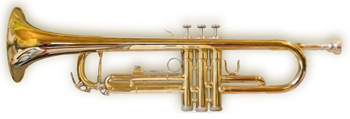Introduction
 This noble instrument is constructed of brass tubing which has been shaped into a rough spiral and although the bore of the trumpet is roughly cylindrical, it could be more accurately described as a complex series of tapers, smaller near the mouthpiece and larger when approaching the flair of the bell. Modern trumpets are made from a variety of materials and you can even find plastic trumpets available.
This noble instrument is constructed of brass tubing which has been shaped into a rough spiral and although the bore of the trumpet is roughly cylindrical, it could be more accurately described as a complex series of tapers, smaller near the mouthpiece and larger when approaching the flair of the bell. Modern trumpets are made from a variety of materials and you can even find plastic trumpets available.
The trumpet sound is produced by blowing air through closed lips into the mouthpiece and creating a rasping or buzzing sound which makes the air vibrate inside the trumpet. The player is then able to vary (by changing the shape of his or her lips) the pitch of the note according to the available range of overtones or harmonics. In the same way as the horn, the trumpet was originally a natural instrument – only able to obtain notes in the harmonic series from a fundamental note. This led to trumpets crooked in different keys being found in scores of the classical period.
The B-flat Trumpet
The B-flat trumpet is probably the most commonly used trumpet in any form of music today. It is an example of a transposing instrument, so it actually sounds a tone lower. Probably because of the history of the trumpet and also because often a trumpet player will decide to play a particular passage on a different trumpet from the indicated on the written page, trumpet players tend to be extremely capable of transposing music at sight.
Although the trumpet is capable of extreme agility, it is always wise not to write rapid passages for any great length of time in a score. (By means of single, double and triple challenging, these extremely rapid staccato passages may actually be performed). It is always worth remembering that trumpet players are human and do need time to breathe after all! Read more about trumpet types.
The Trumpet’s Dynamic Range
The trumpet is probably at its most dynamic when used for brilliant parts. A good example is the opening of Gustav Mahler’s fifth Symphony. The instrument is also very capable of highly dignified, noble and slow-moving phrases – eg. in Wagner’s Prelude to “Parsifal“.
Vibrato is always best used sparingly on the trumpet as it can sound somewhat excessive if overdone. This has, in fact, been exploited to great effect in the famous “spaghetti western” movies of legendary filmmaker Sergio Leone. Our dedicated trumpet range page goes into more detail including video clips.